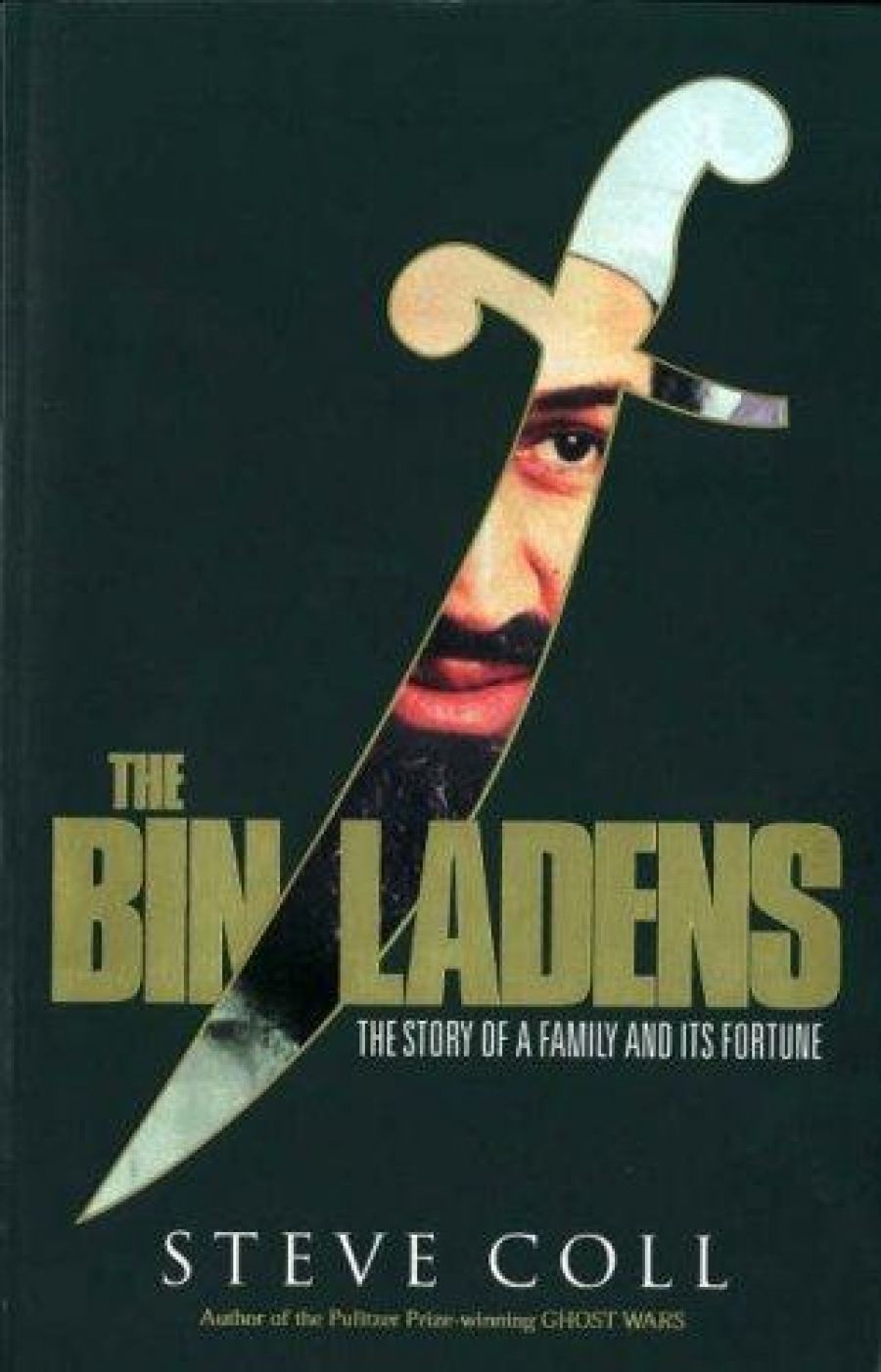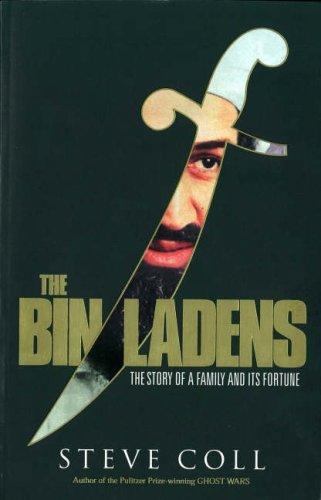
- Free Article: No
- Contents Category: Non-fiction
- Custom Article Title: Fertile times
- Review Article: Yes
- Article Title: Fertile times
- Online Only: No
- Custom Highlight Text:
Between the mid-1940s and the late 1960s, Mohammed bin Laden fathered fifty-four children (twenty-five sons, twenty-nine daughters) from an assortment of wives (he married twenty-two times). It should hardly surprise that such a large group included several extreme personalities. The eldest son, Salem, channelled his manic energy into aeroplanes, cars, girls and the good life. The eighteenth son, Osama, born in 1957, chose a very different path. This would eventually leave New York’s skyline smouldering, Osama repudiated by his family and disowned by his country: a ‘black sheep’ in a league of his own.
- Book 1 Title: The Bin Ladens
- Book 1 Subtitle: The story of a family and its fortune
- Book 1 Biblio: Allen Lane, $35 pb, 671 pp
- Book 1 Cover Small (400 x 600):

- Book 1 Cover (800 x 1200):

The Bin Ladens underlines how much Saudi Arabia’s continuing misgovernance has its origins in the idea that, if the royal family ‘owns’ the state, then it can hardly be criticised for spending the nation’s revenues on itself. Whatever qualms others might have felt about this (then and now), it paid handsomely for Mohammed bin Laden. His astutely crafted royal connections led to grand engineering projects, including in Mecca and Medina in Saudi Arabia, and the Dome of the Rock in then Jordanian-controlled East Jerusalem (Islam’s third holiest site). In the opening ceremony for the latter, Mohammed went to obsequious length to explain how much of his own money had gone into the project.
In September 1967, Mohammed bin Laden died instantly when his light aircraft crashed. The precise extent of his vast wealth was unknown, but he certainly left his large family, including the ten-year-old Osama, well provided for. Salem, flamboyant and charming, took the reins of the family’s businesses and the role of its patriarch. He epitomised the hedonistic jet-setter stream in the family, a stark contrast with the conservative, religiously oriented current from which Osama never really strayed, even though, as Coll notes, he seemed unfazed by the decidedly un-Islamic interest he later earned on his Swiss bank accounts.
Coll writes that during Ramadan, when Salem should have been fasting, he chain-smoked and asked his younger brothers to serve him food and coffee. He ate pork without hesitation and thought it ‘delicious’. When Salem had haemorrhoid surgery in New York, he arranged for a friend to photograph the event. Then he created a multimedia show in which he set a medley of photographs of his backside to music. We might wonder whether the surgery was partly a consequence of the five thousand bottles of Tabasco sauce Salem shipped from America after he developed a taste for the condiment. In one of his most bizarre endeavours, Salem gathered together his British, German, French and American girlfriends and asked them to marry him. He envisaged their residences flying the respective national flags with the respective national motor vehicle parked out front. The offer was declined.
Salem’s passion for flying cost him his life when the ultralight he was piloting slammed into power lines at a Texas airfield in 1988. Coll notes that this was the second time in two decades that bin Ladens had been ‘decapitated by an aviation disaster with an American connection’ (Mohammed’s pilot being ex-United States air force).
As Salem and some of the other bin Laden sons had been treating themselves to the good life, Osama’s religious temperament came increasingly to the fore, encouraged by mentors such as the Palestinian-born Muslim Brotherhood activist, Abdullah Azzam, who had been fired by the Afghan struggle against the Soviet Union. He offered spiritual nourishment; Osama provided cash. Coll writes that for young Saudis in the early 1980s, the ‘Afghan war was fashion … a fund-raising opportunity … a bonding experience – everything but the brutal combat known by the Afghans who actually fought it’. Osama worked hard on his jihadist image. Still, he and Azzam were less interested in becoming martyrs ‘than in creating a movement based on the emotional power of other people’s martyrdom’.
Salem’s death entailed a redistribution of the family wealth. This proved especially timely for Osama, as it coincided with the creation of al Qaeda. He had not yet broken with the Saudi royal establishment, but this came in 1990 with King Fahd’s decision to allow American-led troops to land on Saudi soil to eject Saddam Hussein’s forces from Kuwait and, in the process, to protect the established order in Saudi Arabia itself. Apparently tiring of Osama’s succour of jihadists in neighbouring Yemen, the Saudi authorities seized his passport. He left Saudi Arabia in 1991, relocating to Sudan. There, Osama seemed to believe he could have it all: ‘wives, children, business, horticulture, horse breeding, leisure, pious devotion, and jihad.’ He had not yet grasped the contradiction between his support for violence against governments friendly or dependent on the Saudi régime and the interests of his family in Jeddah. In 1996, Sudan’s government, pressured by the United States, told Osama to leave. He ended up in Afghanistan, this time as an exile, with his anti-Americanism, anti-Semitism and hostility towards those ruling his homeland now at boiling point.
Coll, wisely, does not regurgitate the detail of 9/11. There appears to have been ongoing contact afterwards between some family members and Osama, but the story is murky. The family worked hard to distance itself publicly from Osama. One of his elder half-brothers, Yeslan, issued a statement from Geneva describing 9/11 as a ‘criminal act of terrorism’ and expressing his profound sympathy for the ‘victims, their families and the American people’. With the collapse of the Taliban, Osama prepared for the worst. Some of his sons (as of 2002 he had fathered more than twenty children) stayed with him in Afghanistan, others returned to Saudi Arabia. In a bizarre footnote, one of the latter, Omar, in his mid-twenties, met a 51-year-old English grandmother while horse-riding near the pyramids in Egypt and became her sixth husband. Coll observes wryly that the marriage, which ended in divorce, had to overcome some of the tensions that arose from Omar’s father’s notoriety.
As the months went by and Osama stayed alive and free in Afghanistan, his ‘courage and confidence returned’. Planning for the American-led invasion of Iraq, ‘more than other events, seemed to draw Osama back to himself … the war arrived as a kind of spiritual and political elixir, just when he required it most’.
The Bin Ladens draws on what Coll terms the ‘core’ resources of Peter Bergen’s The Osama Bin Laden I Know (2006) and Lawrence Wright’s The Looming Tower: Al Qaeda and the Road to 9/11 (2006). It is, nonetheless, a substantial work of insightful research and fluent writing, and encourages us to think both about the concept of the nation-state, especially when applied to kleptocracies such as Saudi Arabia, and the internal dynamics and complexities of family. Given the length and scope of the book, we can only hope that any reprint will contain both a map and a timeline.


Comments powered by CComment